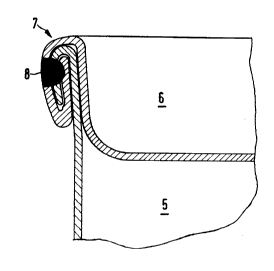Note : Les descriptions sont présentées dans la langue officielle dans laquelle elles ont été soumises.
12792Z8
1 METHOD OF PRODUCING A FOLDED EDGE
2 The invention concerns a method of producina a folded edge
3 in accordance with the preamble to the major claim.
The body of containers made out of fine or extra-fine sheet
6 metal, paint cans and similar containers for example, is
7 usally produced with a welded ioint along the longitudinal
8 seam. Otherwise, the base or upper base is folded to create
9 a folded edge, specifically with a seal inserted as a rule.
11 The tightness of containers of this type must be ensured
12 subject to all conditions, including vacuum and pressure,
13 especially during the shipment of hazardous materials. A
14 complicated folded edge, with a least a double fold and
sometimes even a triple fold, is accordingly usually cre-
16 ated. Since thicker-gauge sheet metal, however, is less
17 deformable, and since the folded edge will have less mechan-
18 ical strength, dropping a full container from even a slight
19 elevation will buckle the fold at that point, so that the
tightness of the container can no longer be sufficiently
21 ensured, which cannot be allowed especially in the case of
22 hazardous materials.
23
24 Eliminating this defect by using thicker sheet is an obvious
step, but also makes the container not only more expensive
26 but considerably heavier.
27
28 The object of the invention is to provide a method of the
29 generic type by means of which the containers can be sealed
permanently, reliably, and dependably even subject to
12792~8
1 mechanical stresses without increasing the thickness of the
2 sheet.
4 This object is attained in a surprisingly simple way in
accordance with the invention by means of a method of the
6 generic type with the characteristics of the body of the
7 major claim.
9 A simple folded edge is created in accordance with the
invention with considerably more mechanical strength that
11 results just from a joint produced by welding at particular
12 points. The folded edge is reliably prevented from buckling
13 subject to mechanical impact stress. The seam can be pre-
14 cisely placed and the intensity adjusted in such a way that
the desired number of layers in the folded edge can be
16 welded together especially by means of fusion welding with a
17 laser. Another advantage is the very small welding site,
18 which renders the folded edge attractive on the exterior and
19 makes further operations unnecessary.
21 In an especially preferred embodiment of the invention the
22 welding occurs at the finish-folded edge. Also preferred is
23 welding over the total folded area, and accordingly with a
24 continuous seam. This considerably increases the height that
the container can fall from without damage. The fold is
26 absolutely tight, and there is no need for any type of
27 inserted seal.
28
29 Other embodiments of the invention will be evident from the
subsidiary claims. The method in accordance with the
1279228
1 invention of manufacturing a novel container will now be
2 described in detail with reference to the drawings. Of
3 these,
Figure 1 is an incomplete and partly broken
6 section through the almost finished folded edge of
7 a container,
9 Figure 2 illustrates the folded edge illustrated
in Figure 1 in the finish-folded state,
11
12 Figure 3 illustrates another embodiment of a
13 folded edge,
14
lS Figure 4 a third embodiment of a folded edge, and
16
17 Figure 5 a fourth embodiment of a folded edge.
18
19
Figure 1 illustrates the body 5 and upper base 6 of a
21 ,container that are to be joined creating a five-layer folded
22 edge 7. The folded edge has at this stage been only incom-
23 pletely produced and a fusion weld in the form of a welding
24 line 8 applied-- from outside-- bonding two layers of folded
edge 7 together. Figure 2 illustrates the completed folded
26 edge 7.
27
28 The second embodiment, illustrated in Figure 3, has a
29 four-layer folded edge 9 with a weld 8 applied to the
finish-folded edge 9 from inside.
~2~92~8
I ~ gure 4 illu~trates a third embodiment of a container
2 manufactured by the method in accordance with the invention
3 and having a three-layer folded edge 10 in which the weld
4 has been applied from outside and involves all three layers.
6 Figure 5 illustrates a third embodiment, a container in
7 which the edge 11 is not initially finish-folded. What will
8 eventually be the outer layer 12 of upper base 6 has not as
9 yet been finally folded down. The welding is carried out at
this unillustrated stage, with the three layers being welded
11 together, specifically body 5 and its outwardly folded outer
12 edge to upper base 6. Only then is layer 12 folded down over
13 weld 8, covering up welding seam 8. No further operations
14 are necessary because the welded seam is invisible from
outside.
19
232 '
24
26
287
29
